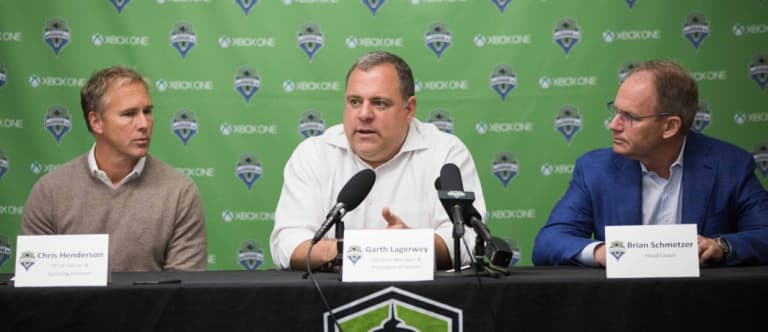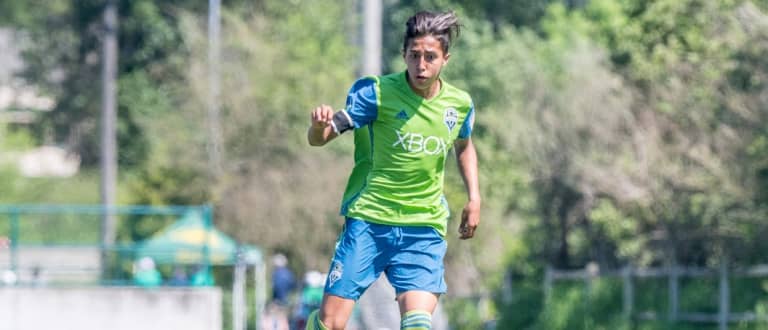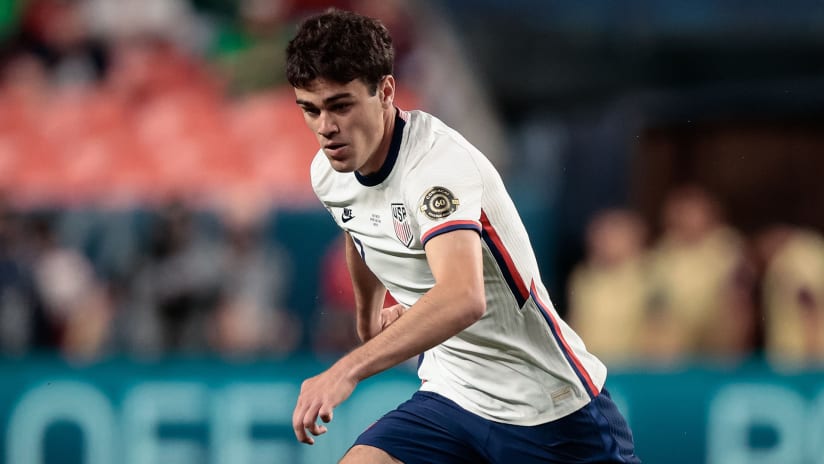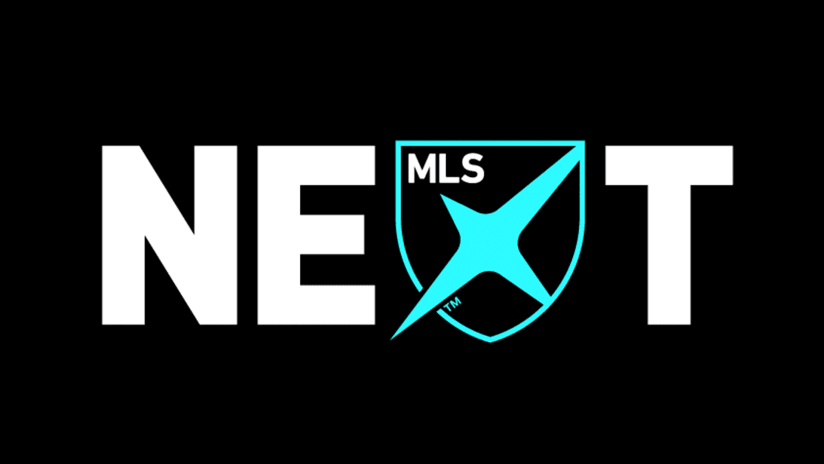Twenty-four hours before the club’s first team cruised to an easy home win against the Colorado Rapids last Saturday night, the future of the Seattle Sounders took a significant step in their road toward MLS.
A slew of Seattle prospects kicked off the USL Championship season with the newly re-branded Tacoma Defiance last Friday, with 17-year-old academy product Alec Diaz scoring to lead the Sounders’ developmental team, previously known as Seattle Sounders FC 2, to a 1-0 home win against Rio Grande Valley FC. For a squad hoping to contend for the playoffs, it was an important result. But for the whole of the Sounders organization, the makeup of the roster was far more notable than the final score.
Six academy products started for Tacoma on Friday, three came off the bench and three more current academy players made the gameday squad. That’s a total of 12 current or former Sounders’ academy players in the 18, the most academy products to make an opening weekend roster for any of the nine MLS-owned teams in the USL Championship.
Of those 12 players, 11 are teenagers. Seven of them are 17 or younger, including highly-touted 15-year-old midfielder Danny Leyva, who has been training with the Sounders first team for the entirety of 2019. He’s one of five or six Sounders who have a real shot to represent the United States in the upcoming qualifying tournament for the 2019 FIFA Under-17 World Cup. Another two have a reasonable chance to suit up for the US in the U-20 World Cup this summer.
Signing academy products to USL contracts and loaning MLS Homegrown players to a USL team isn’t unique to the Sounders, but they have leaned into the practice more than most. They’re promoting more of their kids to USL than just about anyone else in MLS, and they’re doing it at younger ages. The Philadelphia Union, who put 11 academy products in the 18 for their USL side’s opener last weekend, are the only team that’s remotely close. Not all of Seattle’s prospects will pan out, of course, but the hope is that four or five will turn into MLS contributors and one or two will grow into something bigger.
For a club that’s long maintained a place in the league’s elite without getting significant contributions from Homegrown Players, that’s significant. If the Sounders can get more from their academy than the occasional outlier (DeAndre Yedlin or Jordan Morris, for instance) while still signing marquee Designated Players, they should only become more of a force in MLS.
“If we continue to do well in academy and continue to improve pretty dramatically over the next couple years in USL, I really think that’s the recipe for success,” Sounders GM and president of soccer Garth Lagerwey told MLSsoccer.com earlier this week. “If you can get all those levels clicking, you can hopefully build an organization that will stay at the top of MLS for a long, long time to come.”
For a team like Seattle, which doesn’t have as populous or as talent-rich of a Homegrown territory as Los Angeles, New York, Chicago, Toronto or Dallas, getting to this point required significant resources and a carefully considered strategy. When Lagerwey arrived in Seattle from Real Salt Lake in January 2015, the Sounders youth system didn’t look much like it does today.
Yedlin was already in England and Morris, though still at Stanford, was already a full US international, but the club hadn’t gotten much from the rest of their academy and didn’t have as much as they wanted in the pipeline. Academy technical director Marc Nicholls was hard at work building out what he described as a “bare minimum, if probably the norm” setup, but there just wasn’t a ton of organizational emphasis on the youth system.
Sounders owner Adrian Hanauer stepped down as GM and hired Lagerwey in part to change that. Lagerwey understood how important a youth system could be to a club, and he had experience creating a successful academy at RSL. During his time in Utah, he signed now-Mexico international Carlos Salcedo and RSL center back Justen Glad to Homegrown deals and led the development of the club’s Arizona residency program that produced current RSL starters Corey Baird, Brooks Lennon and Aaron Herrera and put five players on the US U-20 World Cup team in 2017.

Chris Henderson and Garth Lagerwey have been two of the chief architects of Seattle's academy revamp. | Seattle Sounders FC
Lagerwey, Nicholls, Sounders technical director Chris Henderson and their staff quickly got to work on a five-year plan to replicate that success. Teams were added, partnerships were formed with youth clubs across Washington, coaches and scouts were hired, medical and educational departments were created. Most importantly, the Sounders began to aggressively look beyond the Seattle region for academy players. That push has paid off.
Seattle’s U-17s dominated the academy circuit last season en route to winning the U.S. Soccer Development Academy national title. A good chunk of that team came from out of the area. That squad’s most important pieces are now in USL. Of the 12 current or former academy products who dressed for Tacoma’s opener last Friday, five (Leyva, Azriel Gonzalez, on-loan MLS Sounder Trey Muse, Alfonso Ocampo-Chavez and Marlon Vargas) were recruited to Seattle’s youth system from outside the club’s Homegrown territory. Several others were recruited from farther afield areas within the Sounders’ Homegrown region and were first pointed out to Seattle by an affiliate club.
“We don’t have players falling out the trees like maybe they do in L.A. or New York City, so we have to think a little bit differently,” said Nicholls. “With that, it’s very much still about the local player here, but we’ve been able to supplement them with players from out of territory and players from out of market and that’s where the club and its resources really come in.”
Importantly, the out-of-area players and local kids have mostly been brought to the club early, with some joining Seattle’s academy as young as age 12. That was by design. The Sounders didn’t want to simply recruit 17- and 18-year-olds and then sign them to Homegrown deals one year later as some sort of “quick fix,” as Lagerwey put it. They wanted to get talented players into their curriculum as early as possible, then advance them to older age groups, USL and MLS as fast as they merited.
The willingness to throw a significant number of youngsters into professional environments is where the Sounders stand out. They’ve never had more under contract than they do currently, but Seattle have signed 15- and 16-year-olds to USL deals for the past couple of years. Lagerwey cited the statistic that “80 percent of UEFA Champions League players make their first-team debut by 17” as part of the motivation behind Seattle pushing academy kids to the pro level at a young age.
“We have that data from Europe that you could do this at 17, so we thought maybe we’re thinking about this the wrong way. Maybe if we get these kids signed at 15 years old, then we give them enough of a development opportunity such that by 17 they’re ready, they’re ready to push in,” said Lagerwey. “We shouldn’t put any obstacles in their way. If they’re good enough, they’re old enough and we have systemically signed these kids at an age where we thought we could really push their development forward.”

15-year-old Danny Leyva has been a regular fixture in Sounders first-team training sessions. | Seattle Sounders FC
Seattle’s obvious end goal is to move some of their academy products from the Defiance to the Sounders, which Lagerwey believes will begin to happen “over the next year or two.” There’s already some integration. Ten academy players spent all preseason with the first team and earned mostly positive reviews. Leyva remains in training with the MLS squad; several other Defiance players will undoubtedly practice with the senior team at different times throughout the year.
Lagerwey and Nicholls expect Tacoma, whose young roster struggled to a 16th-place finish in the 18-team USL Western Conference last season, to contend for a playoff spot this year. They envision their academy products continuing to develop under new head coach Chris Little, who coached many of them with the national champion U-17s last year. Those who progress will be signed to MLS contracts. The club thinks at least a few of those players will make it with the first team. They feel that others will follow in the future. If all goes well, they see a sustainable talent pipeline on the Puget Sound, one that will help Seattle further consolidate their success in an expanding, increasingly competitive MLS.
“We’re in year four now of the program and we think by year five or six, we think we’re going to have some kids, at least some of them, starting for the first team,” said Lagerwey. “That’s the plan. It’s backed by a fundamental belief in the American player. It’s a belief that when MLS expands as rapidly as it has, there’s a dearth of domestic players and the answer is that we simply have to make more. It’s also a recognition that we can’t just always have massive outlays for Designated Players over and over again. We have to have a more replicable system that’s financially coherent as well as development coherent.
“I know that we’ve made the playoffs 10 years in a row, but it gets harder and harder and harder,” he continued. There are more and more teams in MLS, the level of play keeps increasing and you have to continue to do more. You can’t stand pat and do the same things and expect to succeed again. You have to constantly get better, and we believe we’ve made these long-term strategic investments to get better and stay better.”












